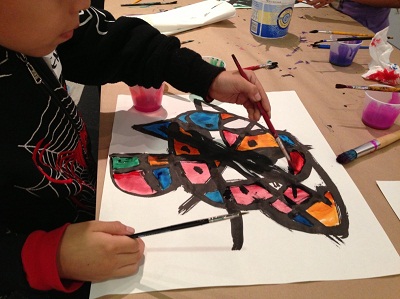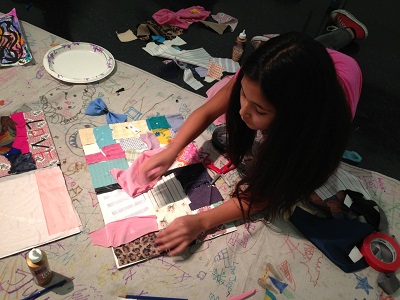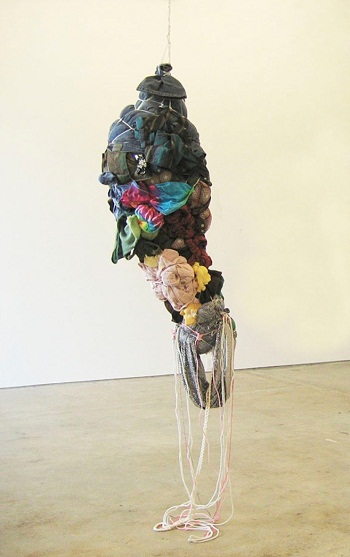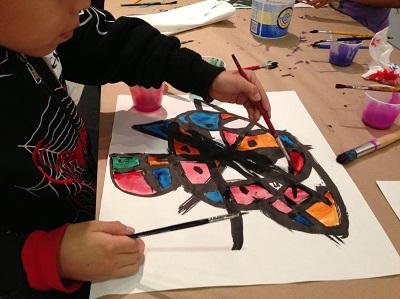We often regard exhibitions primarily as final products, the culmination of considerable work, research, and artistic output. In the case of LACMA’s upcoming exhibition at Charles White Elementary School—Shinique Smith: Firsthand—the show is also a springboard for the artist and museum to further engage the students and community throughout its run.
Last February LACMA invited New York–based artist Shinique Smith to collaborate on a special initiative that involved her exploring the museum’s collection and spending time within the school and surrounding neighborhoods. Smith’s experiences inspired the creation of new work featured in the exhibition, along with objects she selected from LACMA’s costume and textiles collection as well as student art. This spring, Smith will return to Los Angeles and work with the community to further activate this unique space. Sarah Jesse, LACMA’s associate vice president of education, sat down with Smith to chat more about the process and thinking that led to this current stage of the project.
Sarah Jesse: What was it like meeting the students of Charles White?
Shinique Smith: It was refreshing for me to spend time with kids and listen to them defining what the word “inspiration” meant for them. One student said, "Inspiration is something that motivates you." I thought this was pretty solid for a second grader. I agree that true inspiration motivates one to action. My hope is that the kids will find inspiration in their own work and that they will learn to trust and act on their inspirations.
 Young artists at work at Charles White Elementary School
Young artists at work at Charles White Elementary School
SJ: How do you see your work in relation to your selections from LACMA’s costume and textile collection and the artwork students made?
SS: The show has three parts: my work, the kids’ work, and the work of fabulous designers from the collection. Seemingly these components have little in common, but I see the connection within the threads of inspiration from everyday life we have all culled. There were so many pieces in the costume collection to explore. I narrowed things down to process and forms that I felt drawn to aesthetically—garments that explore volume, collage, and pattern and that I felt were kindred to my work. Also, I chose a few designers that I was exposed to and inspired by as a child, like Geoffrey Beene and Bill Blass. The new work that I'm making for the show was influenced by the color of the Yves Saint Laurent piece and the energy I absorbed discovering MacArthur Park and browsing the shops and the fabric district. The area was vibrant with color and texture and sunshine, so I will try to incorporate some of these elements.
 Young artists at work at Charles White Elementary School
Young artists at work at Charles White Elementary School
SJ: Tell us about some of your early influences.
SS: At an early age my mother began exposing me to art and things that would inspire my creativity: coloring in the park, going to museums and performances, going to the library, ballet classes, etc. When I was young, she was studying fashion and designing clothes, so we would explore fabric stores and look at W magazine together. The color and sculptural qualities of her designs were magical to me. She exposed me to Erte because he was one of her personal mentors when she was studying in Paris. They were good friends and she would share his work with me. He was the first artist I endeavored to copy when I was little.
My mother saw an inclination within me that she helped me to cultivate by gently nudging me in that direction. In urging me to go to The Baltimore School for the Arts, I began studying art more seriously and remain on that path. My grandparents’ home and my grandmother's decorating sensibility were inspiring to me. She would mix florals and plaids and patterns that didn't belong together, but they would harmonize. Her home was filled with Romare Bearden reproductions too, so there was collage on the wall and in the room they inhabited. My surroundings influenced me when I was a child, as they do now. I find magic in the relationships of objects and the people that surround me. Perhaps, being an only child is part of it. My play involved imagining worlds in the backyard or under the dining room table, and I guess I still do. I have empathy for us as a people, the lives we lead and what we fill our lives with as humans and I find beauty there.
 Shinique Smith, Swaying Beauty, 2007, gift of Schiff Fine Art, © 2013 Shinique Smith, photo © 2013 Museum Associates/LACMA
Shinique Smith, Swaying Beauty, 2007, gift of Schiff Fine Art, © 2013 Shinique Smith, photo © 2013 Museum Associates/LACMA
SJ: Where do you find all of the materials in your sculptures?
SS: My materials come from multiple sources: my own shelves and closets, my family and friends, thrift stores, department stores, and dollar and fabric stores across the country. Once in a while, I get lucky and find a wonderful toy or object randomly in the world, like an Erkel doll just standing on the corner or a child's drawing on the street. My work begins with observing and collecting. I am most inspired by bringing together bits and pieces of fabric, new items and those with a history of use, so there is a cross section of time, place, and meaning—conceptually and visually. In order to achieve this conglomeration of moments, I have to accumulate “things.” But, I am specific when I collect. I don't just pick up anything or trash, as some may think. The materials I prefer to collect have a particular color or pattern, a relationship to a utopian ideal, something whimsical or relates to other materials in my collection. Currently, I'm really into seascapes, fabrics that incorporate sacred geometry, birds, butterfly wings, and rainbows.
Shinique Smith: Firsthand is on view from February 9 to July 16, 2013, at Charles White Elementary School.



